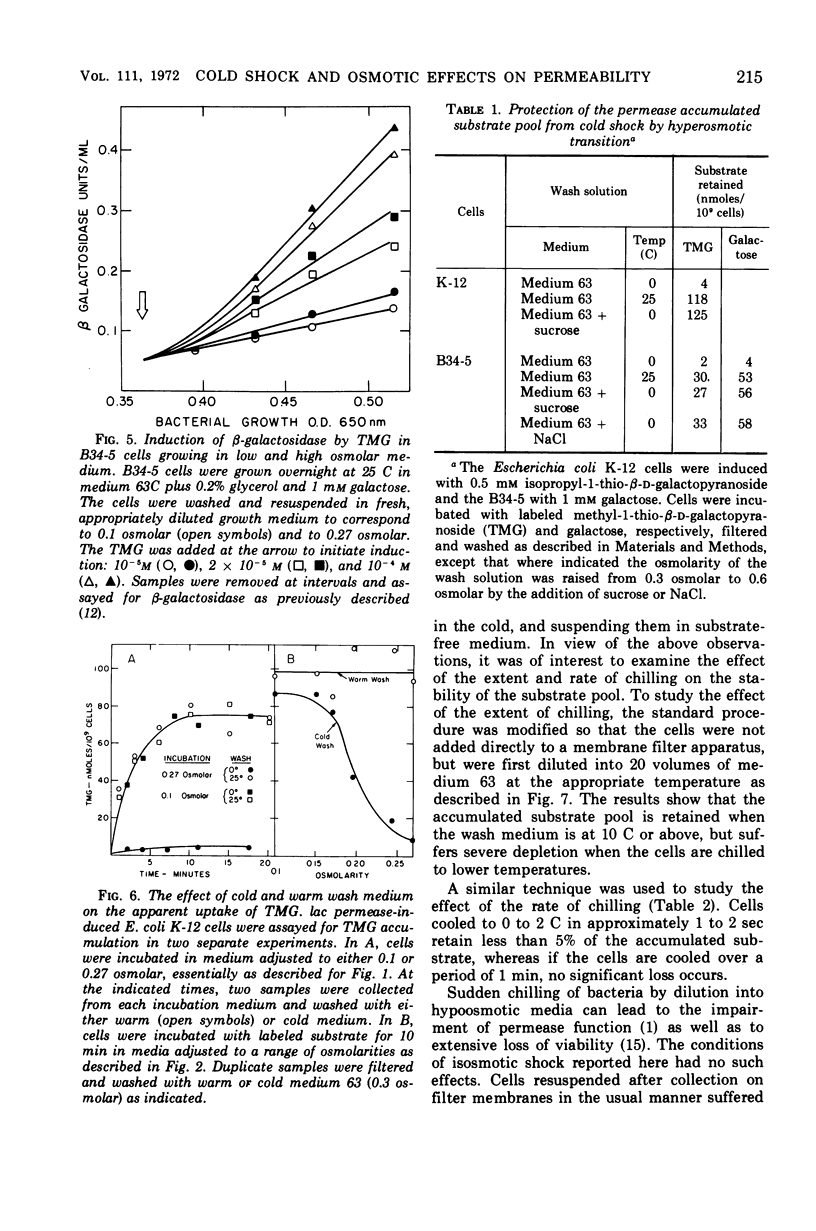Abstract
Permease studies are generally carried out by incubating cells in growth medium with labeled substrate, collecting the cells on microporous membrane filters, and washing them free from extracellular radioactivity with ice-cold medium. Studies of thiomethylgalactoside, valine, and galactose accumulation indicate that in several strains of Escherichia coli the bacterial membrane is exquisitely sensitive to isosmotic cold shock. Substrate pools formed at 25 C may suffer almost total loss if the cells are rapidly chilled to approximately 0 C during sampling. In glycerol-grown cells, this rapid efflux of substrate is prevented or minimized if the cells are subjected at the moment of cold shock to a simultaneous hyperosmotic transition. Because of this protective effect, the apparent size of a permease accumulated substrate pool is extremely sensitive to the osmotic composition of the incubation medium and may appear to be increased as much as 10-fold when the osmolarity is reduced from approximately 0.3 to 0.1 osmolar. These differences vanish when sampling and washing are carried out with medium at room temperature. It is suggested that isosmotic cold shock causes crystallization of the liquid-like lipids within the membrane. The hydrophilic channels created in this process would facilitate the rapid efflux of permease accumulated substrates. The imposition of a simultaneous hyperosmotic transition by dehydrating the cell periphery would cause increased lipid interaction, thus preserving the integrity of the cells membrane.
Full text
PDF








Selected References
These references are in PubMed. This may not be the complete list of references from this article.
- Anraku Y., Heppel L. A. On the nature of the changes induced in Escherichia coli by osmotic shock. J Biol Chem. 1967 May 25;242(10):2561–2569. [PubMed] [Google Scholar]
- BRITTEN R. J., McCLURE F. T. The amino acid pool in Escherichia coli. Bacteriol Rev. 1962 Sep;26:292–335. doi: 10.1128/br.26.3.292-335.1962. [DOI] [PMC free article] [PubMed] [Google Scholar]
- BUTTIN G., COHEN G. N., MONOD J., RICKENBERG H. V. La galactoside-perméase d'Escherichia coli. Ann Inst Pasteur (Paris) 1956 Dec;91(6):829–857. [PubMed] [Google Scholar]
- COHEN G. N., RICKENBERG H. V. Concentration spécifique réversible des amino acides chez Escherichia coli. Ann Inst Pasteur (Paris) 1956 Nov;91(5):693–720. [PubMed] [Google Scholar]
- Heppel L. A. Selective release of enzymes from bacteria. Science. 1967 Jun 16;156(3781):1451–1455. doi: 10.1126/science.156.3781.1451. [DOI] [PubMed] [Google Scholar]
- Holden J. T., Hild O., Wong-Leung Y. L., Rouser G. Reduced lipid content as the basis for defective amino acid accumulation capacity in pantothenate- and biotin-deficient Lactobacillus plantarum. Biochem Biophys Res Commun. 1970 Jul 13;40(1):123–128. doi: 10.1016/0006-291x(70)91055-7. [DOI] [PubMed] [Google Scholar]
- Hubbell W. L., McConnell H. M. Motion of steroid spin labels in membranes. Proc Natl Acad Sci U S A. 1969 May;63(1):16–22. doi: 10.1073/pnas.63.1.16. [DOI] [PMC free article] [PubMed] [Google Scholar]
- KEPES A. [Kinetic studies on galactoside permease of Escherichia coli]. Biochim Biophys Acta. 1960 May 6;40:70–84. doi: 10.1016/0006-3002(60)91316-0. [DOI] [PubMed] [Google Scholar]
- LUZZATI V., HUSSON F. The structure of the liquid-crystalline phasis of lipid-water systems. J Cell Biol. 1962 Feb;12:207–219. doi: 10.1083/jcb.12.2.207. [DOI] [PMC free article] [PubMed] [Google Scholar]
- Leder I. G., Perry J. W. Galactose stimulation of beta-galactosidase induction in galactokinaseless mutants of Escherichia coli. The induction of thiomethylgalactoside permease. J Biol Chem. 1967 Feb 10;242(3):457–462. [PubMed] [Google Scholar]
- Lovett S. Rapid changes in bacteria following introduction into hypertonic media. Proc Soc Exp Biol Med. 1965 Nov;120(2):565–569. doi: 10.3181/00379727-120-30591. [DOI] [PubMed] [Google Scholar]
- MEYNELL G. G. The effect of sudden chilling on Escherichia coli. J Gen Microbiol. 1958 Oct;19(2):380–389. doi: 10.1099/00221287-19-2-380. [DOI] [PubMed] [Google Scholar]
- MONOD J., COHEN-BAZIRE G., COHN M. Sur la biosynthèse de la beta-galactosidase (lactase) chez Escherichia coli; la spécificité de l'induction. Biochim Biophys Acta. 1951 Nov;7(4):585–599. doi: 10.1016/0006-3002(51)90072-8. [DOI] [PubMed] [Google Scholar]
- Novotny C. P., Englesberg E. The L-arabinose permease system in Escherichia coli B/r. Biochim Biophys Acta. 1966 Mar 28;117(1):217–230. doi: 10.1016/0304-4165(66)90169-3. [DOI] [PubMed] [Google Scholar]
- POLLOCK M. R. The measurement of the liberation of penicillinase from Bacillus subtilis. J Gen Microbiol. 1961 Oct;26:239–253. doi: 10.1099/00221287-26-2-239. [DOI] [PubMed] [Google Scholar]
- ROTMAN B., GUZMAN R. Transport of galactose from the inside to the outside of Escherichia coli. Pathol Biol. 1961 Apr;9:806–810. [PubMed] [Google Scholar]
- Ring K. The effect of low temperatures of permeability in Streptomyces hydrogenans. Biochem Biophys Res Commun. 1965 May 18;19(5):576–581. doi: 10.1016/0006-291x(65)90377-3. [DOI] [PubMed] [Google Scholar]
- Smeaton J. R., Elliott W. H. Selective release of ribonuclease-inhibitor from Bacillus subtilis cells by cold shock treatment. Biochem Biophys Res Commun. 1967 Jan 10;26(1):75–81. doi: 10.1016/0006-291x(67)90255-0. [DOI] [PubMed] [Google Scholar]
- Steim J. M., Tourtellotte M. E., Reinert J. C., McElhaney R. N., Rader R. L. Calorimetric evidence for the liquid-crystalline state of lipids in a biomembrane. Proc Natl Acad Sci U S A. 1969 May;63(1):104–109. doi: 10.1073/pnas.63.1.104. [DOI] [PMC free article] [PubMed] [Google Scholar]


